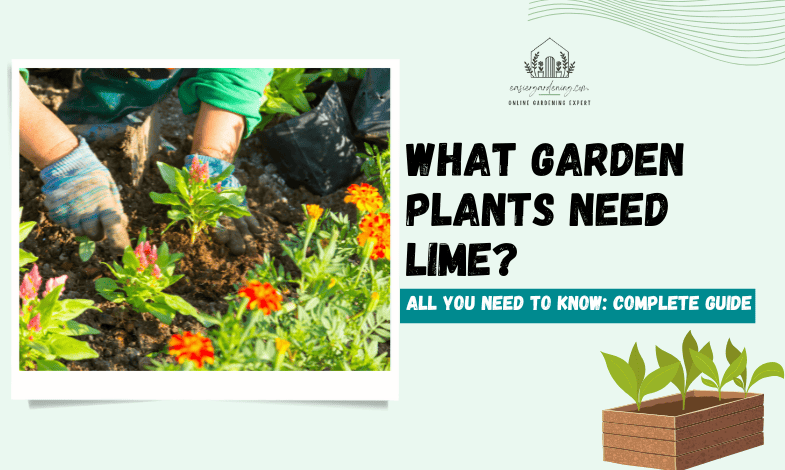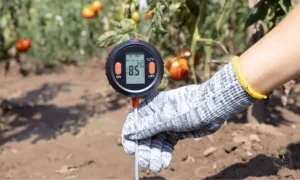What Garden do Plants Need Lime? Guide to Lime Fertilization: Not all plants like the same conditions and prefer different soil types or different soil pH values. You should supply the vegetable garden not only with normal fertilizer but also with lime from time to time. But with a sense of proportion!
Here you will find the most important tips for lime fertilization. Soil pH indicates how acidic (low pH) or alkaline/basic (high pH) a soil is. Some plants prefer acidic soil, but some plants like a neutral or more alkaline soil to grow in.
You can use lime to raise the pH and thus deacidify, neutralize and bring the soil into the alkaline range. The plants that prefer alkaline/basic soil like lime accordingly. However, you should only lime your garden when there is a real lack of lime. Liming the soil only on suspicion can, in the worst case, have the opposite effect and harm the soil. Now, we are going to show you what garden plants need lime & details of lime fertilization in a garden.
Contents
What Garden do Plants Need Lime? List of the Most Popular Plants That Need Lime
In the following table, we have listed the most common plants that need lime. We have distinguished between flowers, vegetables, herbs, fruits, and ornamental shrubs that need lime. So, you will get an idea of what flowers need lime or what vegetables like lime.
|
Flowers |
Vegetables | Herbs | Fruit | Ornamental Shrubs |
| Columbine | All cabbage | Borage | Raspberries | Boxwood |
| Cyclamen | Green asparagus | lavender | Gooseberries | Ivy |
| Asters | Carrots | Oregano | Grapes | Common Rock Pear |
| Flowering perennials | Potatoes | Sage | Hedges | |
| Barberry | Garlic | Chives | Elderberry | |
| Christmas roses | Leek | Woodruff | Butterfly Lilac | |
| Chrysanthemums | Brussels sprouts | Daphne | ||
| Garden globe thistle | Beets | Other shrubs | ||
| Garden silver root | Asparagus | |||
| Gladioli | Chicory | |||
| Small snowdrop | Onions | |||
| Carnations | Celery | |||
| Panicle veil crest | Tomatoes | |||
| Spiraea (spirea shrubs) | ||||
| Roller spurge/colored spurge |
Effects
“Lime makes rich fathers and poor sons,” our grandfathers already knew. The saying gets to the point: If you apply too much lime in the garden, you promote the decomposition of humus. This releases a lot of nutrients in the short term, but it leaches out of the soil in the long term. When the humus content dwindles, the soil structure deteriorates, and the storage capacity for air, water, and nutrients decreases.
Chemically, lime is a compound of the element calcium (Ca). The chemical element is one of the most important mineral building blocks of animals and plants. In animals and humans, calcium is found in higher concentrations in bones and teeth; in plants, calcium is an important building block of cell walls, among other things. Calcium is found in nature in a wide variety of rock types and sediments, almost exclusively as so-called carbonic acid lime, and bears the chemical name calcium carbonate (CaCO3). Most lime fertilizers are based on this raw material.
The so-called lime deposits in the earth are almost exclusively deposited sediments of the primordial oceans, which go back to the lime-rich shells of various sea creatures such as crabs, mussels, snails, and cuttlefish. Over millions of years, layers of rock have formed from them. Where they exist in a particularly pure form, they are often mined for the production of cement and precisely lime fertilizer.
Tips: You have to be very cautious when you are using lime for plants
Indicator Plants Reveal Lime Deficiency
Various indicator plants provide clues to the lime balance of your soil. Reliable indicators of a low lime content are, for example, mustard, hare’s-foot trefoil, three-leaved speedwell, mayweed, small sorrel, various types of moss, sand pansies, and field horsetail. Some garden plants also indicate lime deficiency through growth disorders: Dried shoot tips and yellow discolored young leaves are typical characteristics. In tomatoes, lime deficiency leads to blossom end rot. Apples and quinces often show small brown spots on the skin in excessively acidic soils – so-called stippling, which often causes brown spots in the flesh of the fruit.
Soil Type and pH Value
In a curiosity like what garden plants need lime, the soil type, and its pH value are very important. Loam and loess soils in vegetable gardens should have a pH of 7, sandy loam soils should be at pH 6.5, and loamy, sandy soils should be at pH 6. Pure sandy soils should not fall below a pH of 5.5. For lawns and perennial beds, the limits for all four soil types can be set about 0.5 lower. Rhododendrons and other so-called bog plants, as well as summer heather, hydrangeas, and camellias, do not tolerate lime, so you should avoid liming here.
Note: The pH value of loamy soils must always be somewhat higher, not least because below pH 5.5, a chemical process takes place that is harmful to many plants: the soil acid decomposes the clay minerals and dissolves the aluminum salts stored in them. The sharply increasing aluminum concentration in the soil leads to growth disorders in many plants.
Lime Fertilizers at a Glance
Depending on the soil type and desired nutrient composition, you have a choice of different lime fertilizers for the garden:
Garden Lime
This is ground, poorly soluble limestone made from carbonic acid lime with a low magnesium content. Garden lime is used for light and medium soils and should be applied in autumn or winter if possible. It develops its effect slowly and gently. Carbonic acid lime with a high magnesium content is also available under the trade name “dolomite lime.”
Rock Flour
Rock powders often contain carbonic acid lime, magnesium, potassium, and various trace elements. However, depending on the origin and source of rock, the composition can vary greatly. The nutrients must first be made available to plants by microorganisms, so the effect unfolds quite slowly.
Read more about Five Types Of Calathea (A to Z)
Tip: If you enrich your compost with rock flour before decomposition, you can usually do without direct liming of the garden soil.
Quicklime
Quicklime is produced by strongly heating carbonated lime. Quicklime is not recommended for hobby gardeners, as it is very problematic to handle due to its highly corrosive effect (pH 12-13) and can cause blindness if it comes into contact with the eyes. It can also temporarily damage soil life.
Slaked Lime
When quicklime is slaked by adding water, slaked lime is formed. It bears the chemical designation calcium hydroxide (CaOH2). Slaked lime does not develop its effect as quickly as quicklime and is used in agriculture for liming medium-heavy soils. Like quicklime, this form of lime is highly corrosive and not suitable for home gardens.
Lime Marl
Lime marl contains up to 70 percent carbonic acid lime and up to 30 percent clay. It is particularly suitable for improving the storage capacity of very light sandy soils. Lime marl works slowly and sustainably because the clay content helps stabilize the soil’s pH.
Read more about How to Care for a Money Tree? Easy Techniques to Learn
Final Thoughts: What Garden Plants Need Lime?
When you are searching for what garden plants need lime, to determine the exact lime content, you should have your soil analyzed in a soil laboratory. For a rough estimate, however, a simple test kit from a gardening store or a much more expensive electronic pH meter will suffice. However, the result is no more than a guide because the pH value only says something about the actual lime and acid content of the soil to a limited extent. Clay soils have a much better buffering effect than sandy soils. This means that their acidity can be much higher for the same pH value.



